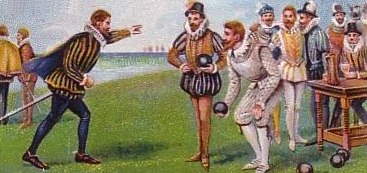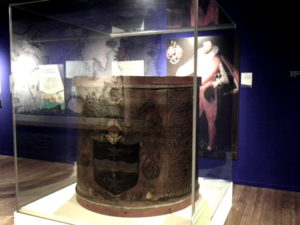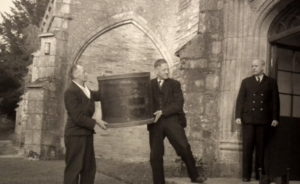The Legend of Drake’s Drum
by Ellen Castelow
https://www.historic-uk.com/CultureUK/Legend-Of-Drakes-Drum/?fbclid=IwAR1KeiOFhNE4hHEAsHcOaSZgRkQrwyt2Mxji9rARdWttE2DLD3t-CX0KqUI
“Take my drum to England, hang it by the shore,
And strike it when your powder’s running low;
If the Dons sight Devon, I’ll quit the port of
heaven, and drum them up the channel as we
drummed them long ago.”
And strike it when your powder’s running low;
If the Dons sight Devon, I’ll quit the port of
heaven, and drum them up the channel as we
drummed them long ago.”
Sir Henry John Newbolt 1862-1938

Sea captain, explorer, slave trader, privateer and pirate: Drake was all of these and more. To the Spanish he was a pirate (El Draque) but to the English, he was a hero. From the singeing of the King of Spain’s beard – his raid on Cadiz in 1587 – to his voyages around the world ( the first Englishman to do so) Drake was immensely popular.
After his death a legend arose involving a drum, emblazoned with his coat of arms, that had reputedly accompanied him on all his voyages. This was an early European side drum, used on board ship for calls to arms or for entertainment; Drake was fond of music and on his circumnavigation, he took four viol players with him on the voyage. Whilst the drum dates from the 16th century, the coat of arms that decorates it was added in the 17th century.
It is generally believed that Drake’s drum was among the 13 drums rescued from Hawkins’ and Drake’s fatal last voyage to the Caribbean in 1596. Shortly before his death off the coast of Panama in 1596, it is said that he ordered the drum to be taken to Buckland Abbey, his home in Devon. He is said to have vowed on his deathbed that if England were ever in danger and the drum was sounded, he would return to defend his homeland.

Drake’s Drum on display at Buckland Abbey, before it was moved to The Box in Plymouth.
– when the Mayflower left Plymouth for the New World in 1620
– when Napoleon Bonaparte entered Plymouth harbour as a prisoner aboard the Bellerophon
– in 1914 on the outbreak of World War One
– in 1918 on HMS Royal Oak just before the surrender of the German fleet
– during the evacuation of Dunkirk in 1940.
Two British army officers also claimed they heard the drum beating during the Battle of Britain in September 1940. It was also said to have been heard beating quietly in 1982 during the Falklands War and on 7th July 2005 when London was hit by a terrorist attack.
The legend of Drake’s drum fits into the category of ‘king of the mountain’ or ‘sleeping hero’ folklore. These are tales of national heroes ready to awake at times of national need, such as the legend of King Arthur and his knights, sleeping in Avalon waiting to arise when required.
Drake’s role as a protector of England is first mooted in a poem written by Charles Fitz Geffrey only a few months after Drake’s death, ‘Sir Francis Drake, His Honourable Life’s Commendation And His Tragical Death Lamentation’. The last few lines of the poem seem to suggest that he is forever watchful over England:
“The sea no more, heaven then shall be his tomb
Where he a new made star eternally
Shall shine transparent to spectator’s eye
But shall to us a radiant light remain
He who alive to them a dragon was
Shall be a dragon unto them again
For with his death his terror shall not pass
But still amid the air he shall remain
This role continued because England wished it to be so! “
The legend was further reinforced in 1897 with the publication of Sir Henry John Newbolt’s famous poem, ‘Drake’s Drum’, some lines from which are quoted at the head of this article.

Drake’s Drum, arriving at Buckland Abbey from Plymouth City Museum, 1951
No comments:
Post a Comment
Please add to our knowledge by leaving a comment here.